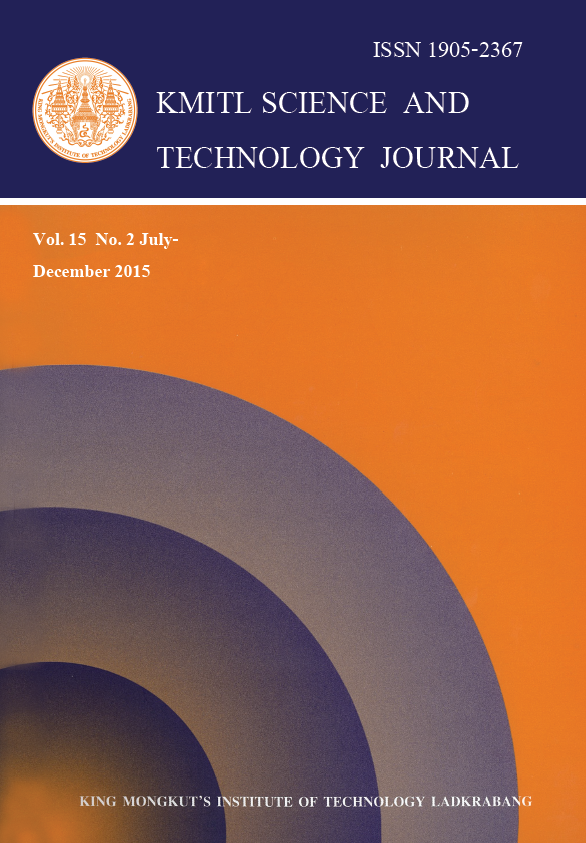Evaluation of Gelatin/Carboxymethylcellulose Scaffolds Using Mooney-Rivlin Model
Main Article Content
Abstract
Scaffolds based on various ratios of gelatin blended with carboxymethylcellulose (CMC) were studied. The scaffolds were fabricated to porous structure via freeze drying process and crosslinked to induce conjugation of free amide and carboxyl groups in protein structures by using thermal crosslinking techniques. The mechanical properties of the scaffolds were characterized both experimental procedure and modeling. In order to evaluate the modeling, the stress-strain behavior of the scaffolds by fitting the data to a Mooney-Rivlin model was decribed. We utilized the Mooney-Rivlin constitutive relationship for soft networks which typically express nonlinear behavior of stress-strain curve from compression test. Results showed that the data distribution of both model and experiment are in the same trend. The models which evaluated CMC blended gelatin scaffold in the ratio of 80 and 20 of gelatin and CMC occurred in the highest average in shear modulus which was 18.12 kPa, compared to G100T, G91T, G73T and G64T scaffolds. Gelatin scaffold blending with 10, 30 and 40% of CMC showed dramatically decreased in the shear modulus which were 7.70, 3.10 and 1.53 kPa, respectively, compared to pure gelatin scaffold with significant difference. These results showed the possibility of using CMC as a low cost material to combine with biopolymers for using in tissue engineering applications.
Keywords: Gelatin, Carboxymethylcellulose, Shear modulus, Hyperelastic material, Mooney-Rivlin model
*Corresponding author: E-mail: fasaiw227@gmail.com
Article Details
Copyright Transfer Statement
The copyright of this article is transferred to Current Applied Science and Technology journal with effect if and when the article is accepted for publication. The copyright transfer covers the exclusive right to reproduce and distribute the article, including reprints, translations, photographic reproductions, electronic form (offline, online) or any other reproductions of similar nature.
The author warrants that this contribution is original and that he/she has full power to make this grant. The author signs for and accepts responsibility for releasing this material on behalf of any and all co-authors.
Here is the link for download: Copyright transfer form.pdf
References
[2] Ma, P.X., 2004. Scaffolds for tissue fabrication. Mater. Today, 30-40.
[3] Yannas, I.V., 2001. Tissue and organ regeneration in adults. Springer-Verlag, New York.
[4] Chong, E.J., Phan, T.T., Lim, I.J., Zhang, Y.Z., Bay, B.H., Ramakrishna, S. and Lim, C.T., 2007. Evaluation of electrospun PCL/gelatin nanofibrous scaffold for wound healing and layered dermal reconstitution. Acta Biomater, 3, 321-330.
[5] Gopinath, D., Rafiuddin, A.M., Gomathi, K., Chitra, K., Sehgal, P.K. and Jayakumar, R., 2004. Dermal wound healing processes with curcumin incorporated collagen films. Biomater, 25, 1911–1917.
[6] Hiraoka, Y., Kimura, Y., Ueda, H. and Tabata, Y., 2003. Fabrication and Biocompatibility of Collagen Sponge Reinforced with Poly(glycolic acid) Fiber. Tissue Engineering, 9, 1101-1112.
[7] Park, J.B. and Bronzino, J.D., 2003. Biomaterials: Principles and Application. CRC Press: Boca Raton, FL, USA.
[8] Piez, K.A., 1985. Collagen. In J.I. Kroschwitz (Ed.), Encyclopedia of Polymer Science and Engineering. Wiley: New York, pp. 699-727.
[9] Timpl, R., 1984. Immunology of the collagens. In K.A. Piez, & A.H. Reddi (Eds.), Extracellular Matrix Biochemistry (pp. 159-190). Elsevier, New York.
[10] Linsenmeyer, T.F., 1982. Immunology of purified collagens and their use in localization of collagen types in tissue. In J.B. Weiss, & M.I.V. Jayson (Eds.). Collagen in Health and Disease. Churchill: Living-stone, Edinburgh, pp. 244-268.
[11] Friess, W., 1998. Collagen-biomaterial for drug delivery. Eur. J. Pharm. Biopharm, 45, 113-136.
[12] Lee, S.B., Kim, Y.H., Chong, M.S., Hong, S.H. and Lee, Y.M., 2005. Study of gelatin-containing artificial skin V: fabrication of gelatin scaffolds using a salt-leaching method. Biomater, 26, 1961-1968.
[13] Biswal, D.R. and Singh, R.P., 2004. Characterisation of carboxymethyl cellulose and polyacrylamide graft copolymer. Carbohydr. Polym, 57, 379-387.
[14] Sanabria-DeLong, N., Crosby, A.J. and Tew, G.N., 2008. Photo-Cross-Linked PLA-PEO-PLA Hydrogels from Self-Assembled Physical Networks: Mechanical Properties and Influence of Assumed Constitutive Relationships. Biomacromolecules, 9, 2784-2791.
[15] Guo, Z.Y., Peng, X.Q. and Moran, B., 2007. Mechanical response of neo-Hookean fiber reinforced incompressible nonlinearly elastic solids. Int. J. Solids Struct, 44, 1949-1969.
[16] Wineman, A., 2005. Some results for generalized neo-Hookean elastic materials. Int. J. Non Linear Mech., 40, 271-279.
[17] Yu, Y.S. and Zhao, Y.P., 2009. Deformation of PDMS membrane and microcantilever by a water droplet: comparison between Mooney-Rivlin and linear elastic constitutive models. Journal of Colloid and Interface Science, 332, 467-476.
[18] Wang, M., Xu, L., Hu, H., Zhai, M., Peng, J., Nho, Y., Li, J. and Wei, G., 2007. Radiation synthesis of PVP/CMC hydrogels as wound dressing. Nucl. Instrum. Methods Phys. Res., Sect. B, 265, 385-389.
[19] Mooney, M., 1940. A theory of large elastic deformation. Journal of Applied Physics, 11(9), 582-592.
[20] Allan, F. and Bower., 2009. Applied Mechanics of Solids. CRC Press. ISBN 1-4398-0247-5. Retrieved January 2010.
[21] Wiwatwongwana, F. and Pattana, S., 2011. Modification gelatin scaffold with carboxymethylcellulose for dermal skin. p.1-4. In Proceedings of the 5th International Conference on Bioinformatics and Biomedical Engineering. 10-12 May 2011. Wuhan, China.
[22] Chen, C.H. and Wang, Y.C., 1997. An extended nonlinear mechanical model for solid-filled Mooney-Rivlin rubber composites. Polymer, 38, 571-576.


